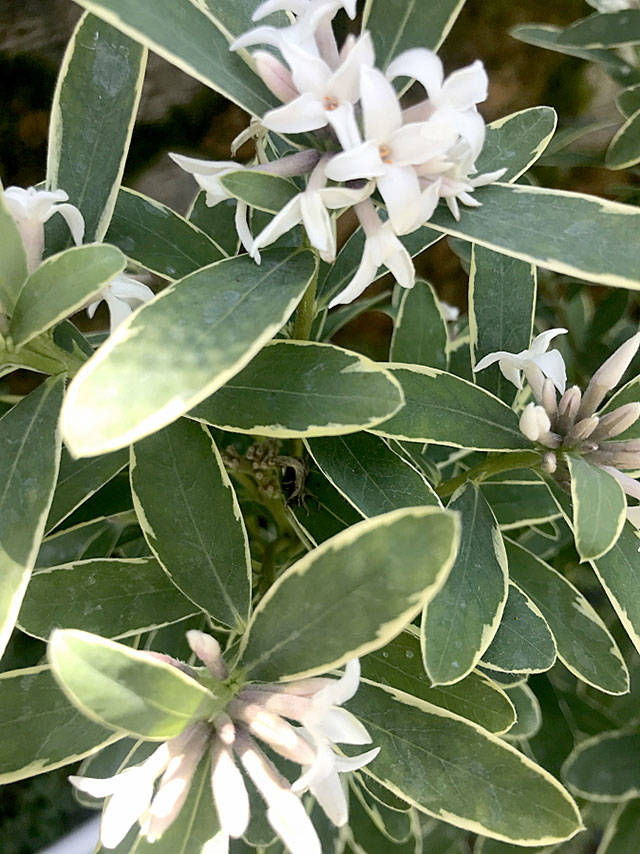By Monika Spykerman / The Columbian, Vancouver
There’s hardly anything that delights the eyes more than a well-tended garden — but what about a garden designed to delight the nose? A fragrance garden might be just the remedy for these stressful times.
You don’t need to be a gardening guru to grow good scents. You don’t even need a garden, because many fragrant plants grow just fine on a patio or balcony. Place them near where you spend the most time, where you’re likely to brush against them and encourage them to release their fragrance.
Make groupings of bright flowers, or create an herb collection that invites touching (thus giving your fingers a treat, too). Try layering fragrances, with creeping thyme on the ground, carnations at knee level, peonies and lilies at waist level, and a lilac overhead.
Roses are a solid choice for a scented garden. They may smell as sweet by any other name, but which varieties smell the sweetest?
Master rosarians Louis and Sally Rossetto of the Fort Vancouver Rose Society were eager to share their favorite fragrant varieties. Louis reeled off a list of strong-smelling roses, including “Fragrant Cloud,” “Mr. Lincoln,” “Firefighter,” “Sweetness,” “Double Delight” and the lavender-colored “Barbra Streisand.”
“’Memorial Day’ is a good smeller,” Louis Rossetto said, “and there’s ‘Pope John Paul,’ a beautiful white rose, and the yellow rose ‘Radiant Perfume.’”
Louis Rossetto noted that many miniature roses have a strong fragrance, like “Overnight Scentsation,” “Golden Celebration” and “Charity.” He said to look for roses cultivated by David Austen, a noted English rosarian who often bred for scent.
Sally Rossetto recommended spring-blooming sweet peas as a scented companion for a climbing rose like “Climbing America,” trained onto an arbor so that blooms are at nose level.
Roses should be planted in the spring after danger of frost, or in the early fall, well before the first frost. (This allows their roots time to get established before the plant goes dormant in winter.) Plant in rich, well-drained soil in a spot that gets about six hours of sun every day.
Which varieties do the Rossettos prefer?
“I’m growing all of them!” Louis laughed.
Kellie Rhodes, lead merchandiser for Yard ‘n Garden Land in Hazel Dell, said a current top seller is the sweet-smelling star jasmine, typically grown as a vine. She also recommends gardenias, an intensely fragrant but low-maintenance flower that thrives in shade and keeps its green leaves year-round. Blush-pink summer daphnes, on the other hand, love the sun and have a long blooming period with a sugary, citrusy scent.
For perennials, Rhodes suggests hyssop, an ancient plant in the mint family with arresting purple-blue blossoms, and echinacea, also called coneflower.
Dianthus has a “kind of clove-y, cinnamon-y fragrance,” she said.
For colorful blooms that pack a big olfactory punch, Rhodes recommended “Casablanca” and “Stargazer” lilies.
Master gardener Christine Anderson offered a wealth of information about growing fragrant plants; see Anderson’s detailed spreadsheet at Columbian.com. She echoed Rhodes’ recommendations regarding daphne and star jasmine, but was also brimming with suggestions for those cultivating container gardens.
“Sweet alyssum and heliotrope can be grown in pots,” Anderson said. “Tuberose would be another one that would be handy for pot culture. Hopflower oregano is beautiful and it’s very cascade-y, so it looks attractive in a pot. Just touching it or brushing against it, you get the lovely scent coming off it.”
She said that pollinators love hopflower oregano. She cautioned that it’s ornamental, not culinary, but it does make a wonderful addition to potpourri.
If you’ve got a shady area, Anderson suggested lilies of the valley or the yellow-and-white “Golden Crane” hydrangea, which can be grown in the ground or in a large pot.
“It’s got lovely form and foliage and flowers,” Anderson said. “They have kind of a jasmine scent.”
For fragrance overhead, lilacs — which can grow to 15 feet tall — can’t be beat. Anderson said large-flowered French types have “wonderful flowers and scent,” but can be prone to disease in wet conditions. The dwarf Korean lilac is more suited to our climate, she said, and thrives in the ground or in a pot with full sun exposure.
A plant doesn’t need big flowers to give off a big smell, however. Herbs offer intense fragrances without showy blooms and provide pleasure for your palate as well as your nose. What’s more, they often thrive in conditions that make other plants wither, such as infrequent watering or poor soil. With full sun and containers with good drainage, even a kitchen windowsill can become a scent garden.
Lavender has been prized since ancient times for its sharp, clean smell and is believed to be particularly calming and to have medicinal uses from easing headaches to soothing irritated skin.
Mint, a fragrance superstar, comes in many unusual food-scented varieties, including chocolate, pineapple, apple, strawberry, banana and grapefruit. (It’s prolific, so put it in pots if you don’t want it to overtake your garden.)
Other highly fragrant, easy-to-grow herbs are rosemary, sage, oregano and thyme, with forms ranging from tall and lush to creeping ground covers that release their scent when stepped on.
Talk to us
> Give us your news tips.
> Send us a letter to the editor.
> More Herald contact information.

























